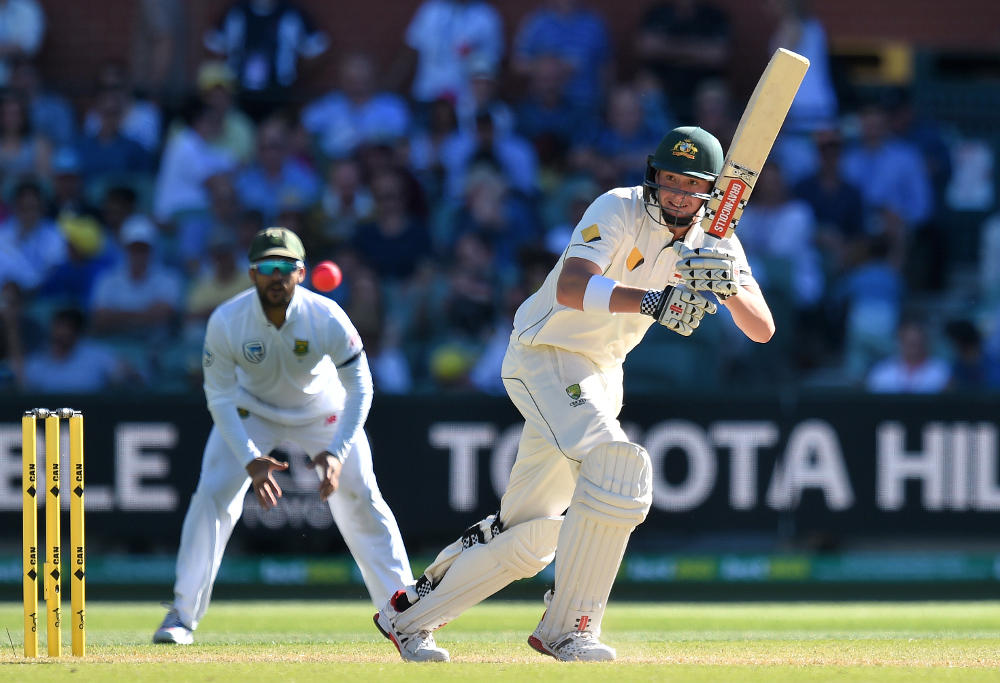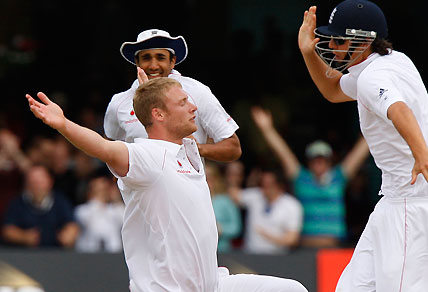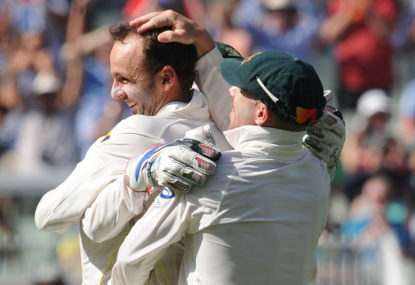David Warner’s 113 was the innings Australia loved. Matt Renshaw’s 167 not out was the innings Australia needed.
Those statements are an oversimplification of course, because Australia at least partly needed and loved both innings. Warner’s innings took Australia to a position of dominance, and Renshaw’s innings ensured that the dominance was maintained throughout the entire day.
Those watching obviously loved Warner’s aggressive batting, just as they loved the contrast of Renshaw’s gradual crescendo.
But in the context of the upcoming Indian tour, Warner’s innings was not necessary to cement his place in the first Test of that tour: Renshaw’s was. Not only has he now got a Test hundred, he’s also shown he can bat an entire day of Test match cricket.

The question of how, and indeed if, to fit Shaun Marsh back into the team has just become more complicated, particularly if Hilton Cartwright scores runs in this Test.
All this points to how Renshaw’s innings was, beyond an individual level, even more important for the composition of the team for India, as it increases the likelihood that the top six will be selected on whether they can make enough runs.
Blaming batsmen for the shortcomings of bowlers is nonsensical. England had more than four bowlers in every match in India, and India’s scores in that series show that it didn’t matter too much. If your best four-man bowling attack can’t get the job done, it’s unlikely more bowlers will do the trick.
There’s also no Ben Stokes or Moeen Ali equivalent in the Australian team, which means the problem of runs would be heightened should the other batsmen fail. While Australia’s top six needs to contribute where they can in the field or with the ball, to place particularly the latter too high an importance on the retention of their spots blurs the lines of accountability.
All this doesn’t change the fact that Tests in Asia are where Mitchell Marsh has performed best with the bat so far in his Test career, with 327 runs at 32.70 in five Tests, including 53 in the last Test at Colombo. But that his best innings of 87 in Abu Dhabi came at No.7 is symbolic of why he should be considered a bowler first and a batsman second, and can only be included if Australia believes its wicket-keeper is the best potential No.6 they can field.
That may have been the case with Matthew Wade in 2013 on the back of his second Test hundred, but his lack of form means that the risk factor of such a move would be heightened.
I am not an all-rounder denier. They do come along, but rarely. Adam Gilchrist has been the one true all-rounder Australia has consistently fielded in the 21st century.
From his debut to the start of the 2005 Ashes, he could be considered a genuine all-rounder. But for every Adam Gilchrist, there are several Shane Watsons.
The former could have made it solely on one of his two skills; the latter could have made it solely as a batsman, and did in his first Ashes series in 2009, but his injury problems prevented him from being an out-and-out bowler.
That is why the lure of an Australian Freddie has survived all these years. Very few players in history could have achieved what he achieved in 2005. Yet the presence of Alec Stewart meant that even as Flintoff was nurtured into Test cricket, England still had six batsmen in the team, providing England with a safety net.
The only time this was not the case was the 2001 tour of India, where Flintoff hardly scored a run while batting at No.6.
To top it off, when England then went to New Zealand, and Flintoff was part of a four-man attack and batted at No.7 (James Foster was at 8).
Christchurch became the site of Flintoff’s first Test century. What England received was developing mastery of a secondary skill as Flintoff became more proficient at his primary skill of bowling.
When Stewart retired, Flintoff’s batting was such that he could bat at No.6, and soften the transition to Chris Read and Geraint Jones.

The lesson of Flintoff is not merely how important the developed version is: it is also how to develop him, with the covering presence of a proven all-rounder.
Australia do not have that all-rounder. But they do have specialists. A right-arm quick, a left-arm quick, a spin bowler who turns the ball away from the right-handed batsman and a spin bowler who turns the ball into the right-handed batsman.
It is a balanced attack, unlike 2008, where an all-rounder was needed to cover debutant spinners.
There is also balance within the specialist batsmen. The top five have all become accustomed to batting in their present positions, and have shown flexibility in different positions before.
If Cartwright succeeds, that’s another specialist with at least one successful innings in the No.6 position, while Marsh has flourished from the opener’s position to No.5. It’s hard to believe that the No.6 position is a bridge too far.
Are they flawless specialists? No. Are they likely to retain the Border-Gavaskar Trophy in India? No.
But they’re Australia’s best chance.
If the batsmen can’t bat well enough, the wicket-keeper can’t keep well enough, and the bowlers can’t bowl well enough, then a player who is not currently as good as the batsmen with the bat and not currently as good as those bowlers with the ball is unlikely to make a difference.
































































































